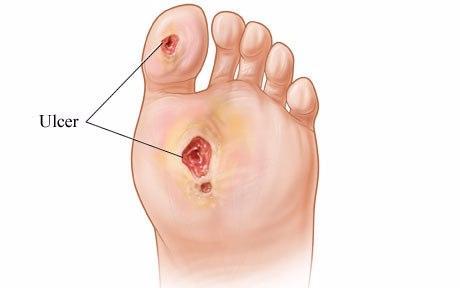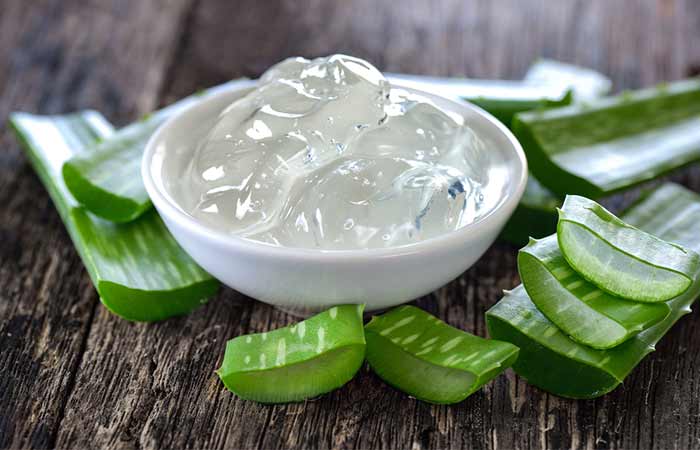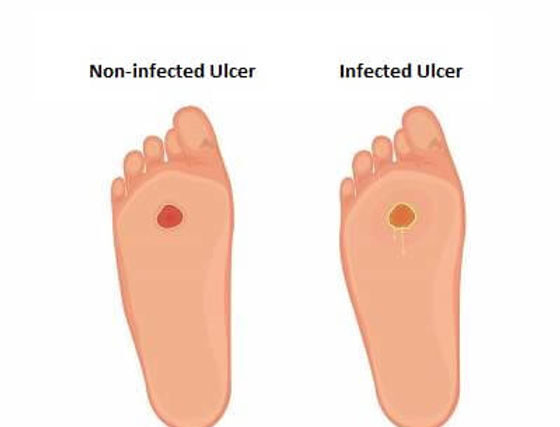Embark on a journey to foot health with our expert guide on preventing and naturally healing foot ulcers. Discover essential tips, lifestyle changes, and innovative treatments to keep your feet happy and healthy.

Introduction
Foot ulcers, often hidden beneath the surface, are not just minor irritations but significant warnings signaling the need for enhanced foot care. These open wounds, typically located on the foot’s underside, can vary in depth and severity, potentially leading to severe health complications if neglected. This guide illuminates the path to understanding the causes, prevention, and natural remedies for foot ulcers, steering you towards recovery and improved well-being.
Table of Contents
What Are Foot Ulcers?
Foot ulcers are not merely discomforts but significant alerts for enhanced foot care. These open wounds, often found on the foot’s underside, vary in depth and severity. Without proper attention, they can evolve into serious health issues.

This guide serves as a beacon, shedding light on the origins, prevention, and natural remedies for foot ulcers, guiding you towards recovery and improved health.
Exploring the Roots of Foot Ulcers
Diabetes
This condition stealthily steals sensation, impeding blood flow and nerve function, which hampers the healing of wounds like foot ulcers.
Ill-Fitting Footwear
The story of poorly fitting shoes warns of the friction and pressure they cause, leading to ulcers and emphasizing the importance of finding the right shoe fit.
Alcohol Consumption
Excessive alcohol intake can cause neuropathy, reducing the foot’s ability to detect injuries, thus increasing the risk of ulcers.
Vascular Diseases
These conditions slow down the healing process by restricting blood flow to the feet, underscoring the vital connection between circulation and wound healing.
Smoking
Smoking hampers circulation, reducing the body’s ability to heal and raising the likelihood of developing ulcers.
Neuropathy
The silent loss of sensation makes it difficult to notice initial injuries, which can develop into ulcers.
Constant Pressure
Ongoing pressure or friction on certain parts of the foot can lead to ulcers, reminding us of the importance of giving our feet rest.
Obesity
Excess weight increases pressure on the feet, heightening the risk of skin breakdown and ulcers, highlighting the need for balance.
Neglected Foot Care
Regular cleaning and moisturizing act as defenses against skin breakdown and infection, essential for preventive care.
Infection’s Gateway
Small wounds can become entry points for bacteria, turning ulcers into sites of inflammation and increasing the risk of severe complications like gangrene.
Limited Mobility
For individuals with restricted movement, continuous pressure on specific foot areas can result in pressure ulcers, emphasizing the importance of frequent position changes.
Aging
With age, our skin and circulation diminish, and conditions like diabetes become more common, placing the elderly at an increased risk of foot ulcers, a reminder of our feet’s changing care needs over time.
The Comprehensive Guide to Preventing Foot Ulcers and Embracing Natural Remedies
Foot ulcers pose a significant risk, especially for individuals with diabetes or compromised circulation, potentially leading to severe health complications. However, with the adoption of preventative measures and the power of natural remedies, it’s possible to maintain healthy, ulcer-free feet. This guide will explore effective strategies for foot care and introduce natural healing methods for those troublesome ulcers.
Initiating Prevention: Essential Measures
Ideal Footwear for Ultimate Protection
Selecting the Right Shoes
Choose shoes that provide a perfect balance of snugness and space, allowing your toes to move freely while ensuring comfort. Opt for breathable fabrics and cushioned soles for ultimate foot pampering, avoiding high heels and shoes with narrow fronts that can cause undue stress.

Tailored Foot Support
For those with specific foot conditions, custom-made orthotics can be invaluable, offering personalized support and ensuring pressure is evenly distributed, treating your feet to the support they deserve.
Routine Foot Checks
Implementation
Adopt the habit of inspecting your feet daily for any signs of distress, such as blisters or cuts. Use a mirror to examine hard-to-see areas, or team up with someone for an effective foot-checking system.

Significance
Early detection is crucial in preventing minor issues from developing into serious problems. Regular monitoring is key to maintaining foot health and preventing ulcers.
Maintaining Health Balance
Managing Diabetes and Circulatory Health
Effective management of diabetes and circulatory issues is crucial in preventing foot ulcers. Follow your medical regimen closely to ensure optimal blood sugar and circulation levels.
Consistent Health Assessments
Incorporate regular professional foot evaluations into your healthcare routine, particularly if you’re at increased risk for foot ulcers.
Natural Remedies for Ulcer Care

Honey: The Antibacterial Solution
Application: After cleaning the ulcer, apply medical-grade honey and secure with a bandage. This should be done daily for best results.
Benefits: Honey’s natural antibacterial properties and moisture regulation support a conducive healing environment, promoting wound recovery.
Aloe Vera: The Pain Reliever
Usage: Apply fresh aloe vera gel directly to the ulcer or on a clean dressing, ensuring the area is clean to prevent infection.
Advantages: Aloe vera’s soothing and anti-inflammatory properties help reduce discomfort and swelling, aiding the healing process.


Turmeric: The Inflammation Fighter
Preparation: Mix turmeric powder with water to create a paste, apply to the ulcer, and cover with a dressing, changing it daily.
Efficacy: Turmeric is renowned for its anti-inflammatory and antioxidant capabilities, thanks to curcumin, aiding in reducing inflammation and promoting wound healing.
Additional Healing Tips

Moisture Management: Maintain a clean and moist environment for the ulcer, consulting a healthcare professional for the best moisturizing practices.
Pressure Mitigation: Use cushioned insoles or specialized diabetic footwear to alleviate pressure on the feet, facilitating ulcer healing.
Nutritional Support: Enhance your diet with nutrient-rich foods, including lean proteins, vitamin C-rich fruits, zinc, and omega-3 fatty acids, to support the body’s healing mechanisms.
By implementing these preventative and natural care strategies, you can effectively protect your feet from ulcers, promoting healing and maintaining overall foot health.
Revolutionizing Foot Ulcer Management: A Holistic and Technological Approach
Managing foot ulcers extends beyond just surface-level treatments; it’s about embracing a holistic lifestyle transformation. This comprehensive shift not only aids in the healing of existing ulcers but also strengthens your defenses against future occurrences. Explore the lifestyle changes that serve as a beacon of hope for those dealing with foot ulcers.
Nourishing Recovery: A Dietary Approach
What to Eat:
- Vitamin C: Incorporate citrus fruits, strawberries, bell peppers, and broccoli into your diet to support collagen production and wound healing.
- Zinc: Include beef, pumpkin seeds, lentils, and chickpeas in your meals to boost your immune system and promote healing.
- Protein: Consume lean meats, fish, poultry, tofu, and beans to aid tissue repair and recovery.
- Omega-3 Fatty Acids: Add salmon, mackerel, flaxseeds, and walnuts to your diet to combat inflammation and support wound healing.
How It Helps:
A balanced diet acts as a foundation for healing, providing a mix of essential nutrients that rejuvenate the skin, strengthen the immune system, and enhance overall health.
Embracing a Smoke-Free Life
Quitting Smoking:
- Set a Quit Date: Choose a realistic date to start your smoke-free journey.
- Identify Triggers: Recognize and prepare for situations that tempt you to smoke.
- Seek Support: Utilize support groups, counseling, nicotine replacement therapy (NRT), or prescription medications.
- Stay Active: Use physical activity to reduce cravings and withdrawal symptoms.
Impact on Healing:
Quitting smoking boosts circulation, essential for delivering nutrients and oxygen to heal ulcers.
Mastering Stress Management
Strategies for Stress Reduction:
- Yoga and Meditation: Utilize these practices to lower stress hormones and promote a healing state of calm.
- Gentle Exercise: Opt for low-impact activities like walking or swimming to enhance blood flow and relieve stress.
- Deep Breathing: Use breathing exercises to reduce stress effectively.
- Time Management: Balance your responsibilities with rest to minimize stress.
Why It Matters:
Managing stress is crucial as it can dampen the immune response and slow the healing process.
Implementing Lifestyle Changes
Monitoring Progress
Keep a Nutrient Log: Track your intake of healing nutrients.
Celebrate Smoke-Free Milestones: Acknowledge every step towards a smoke-free life.
Assess Stress Management Techniques: Regularly evaluate the effectiveness of your stress-reduction strategies.
Professional Guidance
Nutritional Counseling: Seek advice from a dietitian for a healing-focused diet.
Smoking Cessation Support: Consult with experts for personalized quitting strategies.
Mental Wellness Assistance: Engage with a therapist for stress management support.
Navigating Recovery with Professional Care
Healing foot ulcers is a journey that demands vigilant attention, a commitment to enhancing overall health, and the wisdom to know when professional medical intervention is essential. While home remedies play a supportive role, recognizing when to seek expert medical advice is crucial for effective recovery and preventing further complications.
Knowing When to Seek Professional Help
Consulting a healthcare professional is vital in the following situations:
| Severe Ulcers |
| Immediate medical attention is necessary if an ulcer exposes bones or tendons, indicating severe tissue damage. |
| Infection Indicators |
| Symptoms like increased redness, warmth, or pus indicate an infection that requires prompt medical intervention to prevent more severe health issues. |
| Stalled Healing |
| If there’s no sign of healing after a week of consistent home care, it’s time to get a healthcare provider’s evaluation to revise the treatment strategy and ensure progress. |
The Path to Healing
The path to recovering from a foot ulcer involves more than just treating the wound; it requires a holistic health strategy. Effective prevention and management include adhering to a nutritious diet, maintaining proper foot hygiene, selecting appropriate footwear, and managing any underlying health conditions, such as diabetes or vascular diseases, that increase ulcer risk.
Although natural remedies offer anti-inflammatory and antibacterial benefits, they should complement, not replace, conventional medical treatments, especially for severe ulcers or when infection is present.
Technological Advances in Foot Ulcers Treatment
The treatment of foot ulcers is being transformed by technological advancements, providing new hope and better outcomes for patients. These innovations enhance traditional treatment methods, offering a tailored approach to individual patient needs.
Smart Bandages and Wound Dressings
These advanced dressings, equipped with sensors, monitor wound conditions like moisture levels, pH, and temperature in real-time, aiding healthcare providers in making informed treatment decisions. Some are even capable of delivering medication directly to the ulcer, ensuring targeted treatment.
Telemedicine and Remote Monitoring
Telemedicine has revolutionized foot ulcer management by making specialist care more accessible from home. Remote monitoring tools further support this by allowing patients and doctors to track healing progress, facilitating timely treatment adjustments.
Custom Orthotics and 3D Printing for Foot Ulcers
3D printing technology allows for the creation of custom orthotics and footwear, significantly reducing pressure points and preventing new ulcers. Patients have reported not only faster healing rates but also increased comfort and mobility.
These technological advancements signify a new era in personalized, efficient, and effective foot ulcer care. By incorporating these innovations, healthcare providers can deliver superior outcomes, marking a significant advancement in the fight against foot ulcers.
Regenerative Medicine
Techniques such as stem cell therapy and growth factor therapy are at the forefront of ulcer treatment, aiming to enhance the body’s natural healing processes. This approach has shown promise in speeding recovery and improving outcomes.
FAQ Section
Q: What are the main causes of foot ulcers?
A: Foot ulcers can result from diabetes, poor footwear, alcohol consumption, vascular diseases, smoking, neuropathy, constant pressure, obesity, and lack of foot care, each contributing to the risk and severity of ulcers.
Q: How can I prevent foot ulcers?
A: Prevention strategies include selecting the right shoes, daily foot inspections, managing diabetes and circulatory health, and regular health assessments to maintain optimal foot health and prevent ulcers.
Q: What natural remedies can help heal foot ulcers?
A: Natural remedies such as applying medical-grade honey, using aloe vera gel, and creating turmeric paste offer antibacterial, soothing, and anti-inflammatory benefits, supporting the healing process.
Q: When should I seek professional help for a foot ulcer?
A: Seek professional medical attention if you notice severe ulcers exposing bones or tendons, signs of infection like increased redness or pus, or if the ulcer shows no improvement after a week of consistent home care.
Conclusion
Navigating the recovery from foot ulcers demands vigilant care, a commitment to holistic health, and the discernment to seek professional advice when necessary. By understanding the underlying causes and embracing both preventative measures and natural remedies, individuals can effectively safeguard their feet against ulcers. Moreover, the integration of technological advancements in treatment offers new hope and improved outcomes, marking a significant step forward in foot ulcer care. Embrace these strategies to revitalize your foot health and step confidently into a future free from the pain and complications of foot ulcers.



MOST COMMENTED
Animal-Based Proteins / Casein Protein / Dietary Protein / High-Protein Diets / Pea Protein / Plant-Based Proteins / Protein / Protein Deficiency / Protein Supplements / Proteins / Whey Protein / Whey Proteins
Is Protein Powder Safe for Teenagers and Children?
Animal-Based Proteins / Casein Protein / Dietary Protein / High-Protein Diets / Pea Protein / Plant-Based Proteins / Protein / Protein Deficiency / Protein Supplements / Proteins / Whey Protein / Whey Proteins
Unlock the Power of Proteins for Optimal Gut Health
Multivitamin
Total Health: Multivitamin for Active Lifestyles
Multivitamin
WellnessFusion: Complete Multivitamin Support
Dietary Supplement
Revitalize Your Health: The Magic of Red Yeast Rice Capsules
Foot care / Foot Health
Revitalize Your Foot Care Routine: Essential Tips for Optimal Foot Health
Foot Problem / Diabetics / Foot Health
Diabetics: Mastering Footwear Selection for Enhanced Foot Health and Ultimate Comfort
Exercises and Footwear Tips for Hammertoe Relief / Foot care / Foot Health / Foot Pain / Foot Problem / Hammertoes
Unlock Effective Exercises and Footwear Tips for Hammertoe Relief
Hammertoes / Foot Health / Foot Pain / Foot Problem
Unlock Relief: Essential Guide to Hammertoes Causes, Symptoms, and Treatments
Foot Problem / Foot Health
Revolutionize Your Recovery: Natural Remedies for Plantar Fasciitis – Fresh Home Keepers